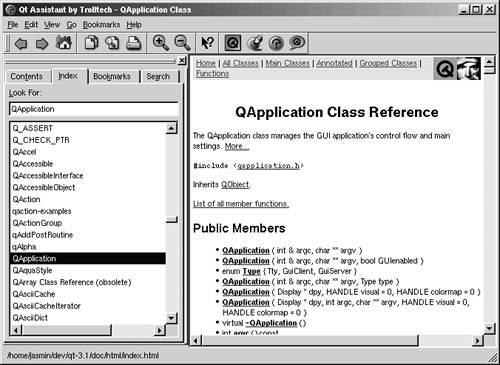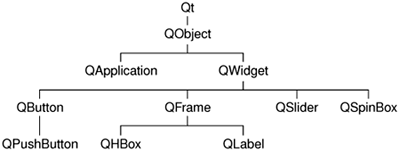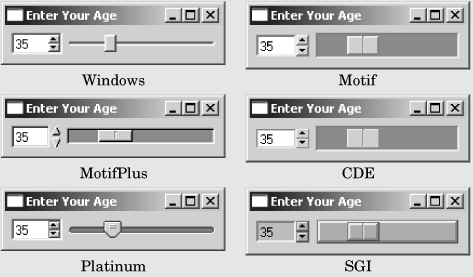Using the Reference Documentation
Qt's reference documentation is an essential tool for any Qt developer, since it covers every class and function in Qt. (Qt 3.2 includes over 400 public classes and over 6000 functions.) This book makes use of many Qt classes and functions, but it doesn't mention them all, nor does it provide all the details of those it does mention. To get the most benefit from Qt, you should familiarize yourself with the Qt reference documentation.
The documentation is available in HTML format in Qt's dochtml directory and can be read using any web browser. You can also use Qt Assistant, the Qt help browser, whose powerful search and indexing features make it quicker and easier to use than a web browser. To launch Qt Assistant, click Qt 3.2.x|Qt Assistant in the Start menu on Windows, type assistant on the command line on Unix, or double-click assistant in the Mac OS X Finder.
Figure 1.9. Qt's documentation in Qt Assistant

The links in the "API Reference" section on the home page provide different ways of navigating Qt's classes. The "All Classes" page lists every class in Qt's API. The "Main Classes" page lists only the most commonly used Qt classes. As an exercise, you might want to look up the classes and functions that we have used in this chapter. Note that inherited functions are documented in the base class; for example, QPushButton has no show() function of its own, but it inherits one from its ancestor QWidget. Figure 1.10 shows how the classes we have seen so far relate to each other.
Figure 1.10. Inheritance tree for the Qt classes seen so far

The reference documentation for the current version of Qt and for some earlier versions is available online at http://doc.trolltech.com/. This site also hosts selected articles from Qt Quarterly, the Qt programmers' newsletter sent to all commercial licensees.
Part I: Basic Qt
Getting Started
- Getting Started
- Hello Qt
- Making Connections
- Using the Reference Documentation
Creating Dialogs
- Creating Dialogs
- Subclassing QDialog
- Signals and Slots in Depth
- Rapid Dialog Design
- Shape-Changing Dialogs
- Dynamic Dialogs
- Built-in Widget and Dialog Classes
Creating Main Windows
- Creating Main Windows
- Subclassing QMainWindow
- Creating Menus and Toolbars
- Implementing the File Menu
- Setting Up the Status Bar
- Using Dialogs
- Storing Settings
- Multiple Documents
- Splash Screens
Implementing Application Functionality
- Implementing Application Functionality
- The Central Widget
- Subclassing QTable
- Loading and Saving
- Implementing the Edit Menu
- Implementing the Other Menus
- Subclassing QTableItem
Creating Custom Widgets
- Creating Custom Widgets
- Customizing Qt Widgets
- Subclassing QWidget
- Integrating Custom Widgets with Qt Designer
- Double Buffering
Part II: Intermediate Qt
Layout Management
- Layout Management
- Basic Layouts
- Splitters
- Widget Stacks
- Scroll Views
- Dock Windows
- Multiple Document Interface
Event Processing
- Event Processing
- Reimplementing Event Handlers
- Installing Event Filters
- Staying Responsive During Intensive Processing
2D and 3D Graphics
Drag and Drop
Input/Output
- Input/Output
- Reading and Writing Binary Data
- Reading and Writing Text
- Handling Files and Directories
- Inter-Process Communication
Container Classes
Databases
Networking
XML
Internationalization
- Internationalization
- Working with Unicode
- Making Applications Translation-Aware
- Dynamic Language Switching
- Translating Applications
Providing Online Help
- Providing Online Help
- Tooltips, Status Tips, and Whats This? Help
- Using QTextBrowser as a Simple Help Engine
- Using Qt Assistant for Powerful Online Help
Multithreading
- Multithreading
- Working with Threads
- Communicating with the GUI Thread
- Using Qts Classes in Non-GUI Threads
Platform-Specific Features
EAN: 2147483647
Pages: 140


